Special Contribution from: Jung Youl Kawk, General Manager of JYSG
Over the course of 19 years, marked by both significant challenges and substantial growth, JYSG has navigated a remarkable path. It is with great privilege that I share our journey towards the implementation of blended interactive teaching, and how this approach has notably enhanced both the quality of education that we have delivered and the learning outcomes for our students.
Previously seen as a thriving and lucrative sector, tutoring institutions are now perceived as dwindling, marking a shift towards becoming a sunset industry.
Data reveals that Seoul is home to 24,284 tutoring centers, a number that surpasses that of convenience stores by approximately threefold. This prevalence is especially notable in the Gangnam Daechi-dong area, renown for its “Tutoring Street,” which alone boasts 1,609 of these centers.
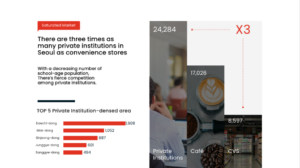
Under these circumstances, tutoring centers face fierce competition every month to recruit new students and minimize dropouts. This competitive environment is not just due to the sheer number of educational organizations but also stems from the prevalent “tuition payment method.”
Most tutoring institutions in South Korea adopt a monthly payment method. This means that institutions must earn the trust and approval of students and their parents every month. This situation presents both opportunities and challenges; while it offers tutoring centers with genuine value a chance to quickly attract students, it also means there is no room for complacency, as the battle for preference is renewed with each passing month.

In fact, it’s common for Korean students to explore different tutoring options after the exam period, often changing their tutoring centers the same way one might switch shopping destinations.
Nevertheless, institutions that stand out in terms of instructional quality and effectiveness tend to see students returning even after they’ve temporarily left. Notably, the number of students who re-enrolled at JYSG this year has tripled compared to the same period last year – and the statistics were gathered even before March was half over.
The phenomenon of “students dropping out and re-enrolling” serves as a testament to the distinct competitive edge that JYSG holds over its counterparts.

Currently, in South Korea’s tutoring market, the most common strategy for tutoring centers is to “recruit top students.” Securing a roster of high-performing students not only enhances an institution’s reputation but also serves as a magnet for attracting more top-tier and average to under-performing students, a critical aspect of the recruitment strategy.
To stand out in this competitive market, numerous tutoring centers deploy tactics such as offering scholarships or teaching materials in advance to entice the best students. Additionally, another widely adopted practice is the teaching of highly challenging problems, known in Korea as “killer questions.” By specializing in and teaching the methods to solve these complex questions, institutions position themselves as appealing choices for ambitious students looking to gain an edge in their academic pursuits.
Initially, we sought to attract high-performing students using the common strategies adopted by many institutions, but the uniformity of these approaches made it difficult to compete with elite institutions. Consequently, JYSG redirected its focus towards students with mid-to-lower grades who want to improve their academic performance.
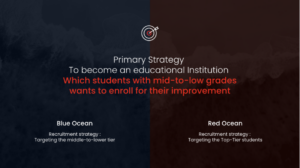
The majority of institutions overlook the strategic approach to recruit average or under-performing students, fearing that a significant presence of such students might degrade their brand image and hinder the attraction of top-tier students.
About ten years ago, we started to specifically target these average or under-performing students, dedicating efforts to enhance their skills and academic performance. Our aim was to assist these students in significantly improving their exam results, positioning JYSG as the preferred educational institution for students seeking to elevate their academic standing from average or below-average levels.
Yet, this approach has faced various challenges. The first challenge is that enhancing the performance of these students is incredibly difficult; traditional teaching methods often failed to make a meaningful impact on their grades. Another challenge is the general societal disinterest in the academic improvement of these students. In reality, the academic journey of a student improving from a level 2 to a level 1 is often celebrated more than that of a student advancing from level 7 to level 3, even though the latter achievement requires overcoming greater challenges and is, regrettably, frequently disregarded.
Therefore, in Korea, a notable hesitation exists among teachers when it comes to tutoring average or under-performing students, presenting a third significant challenge. Many teachers perceive the task of tutoring lower-performing students as having little to no positive impact on their career advancement.
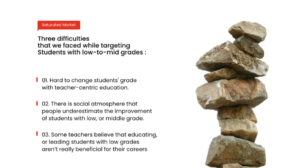
However, the past two years have seen significant changes in Korea’s education sector, with a notable shift in societal attitudes.
For example, recent Korea TV shows focusing on improving the grades of average and under-performing students, or similar content on social media channels like YouTube, have attracted substantial attention from both parents and students. In addition, many celebrated tutors, often referred to as “start teachers,” have begun to implement strategies specifically aimed at these groups of students.
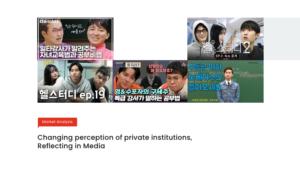
The image showcases some of Korea’s most esteemed tutors, with their annual earnings potentially surpassing ten billion Korean won ($7.4 million). Their primary role involves helping students to advance from below-average academic performance to average levels. Through such shows, many Korean parents have come to realize the immense challenge in elevating the academic performance of average and below-average students, along with the significant efforts these teachers have put in.
At JYSG, our primary strategy is dedicated to supporting underperforming students in improving their academic standings. Given the prevailing shift in societal attitudes, we believe this methodology to be particularly effective in helping these students achieve their goals. Our objective is to facilitate a substantial academic improvement for these students, positioning ourselves as a leading institution capable of significantly elevating students’ academic skills, grades, and performance in entrance examinations.
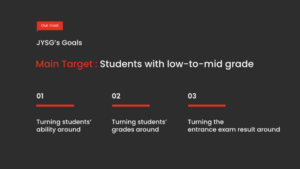
After years of experience as an educator, I’ve come to understand that achieving our objectives necessitates a shift from the traditional “teacher-centered” model to a “student-centered” approach, thereby redefining our teachers as “Learning Facilitators”. This shift implies that education should prioritize the needs and interests of students over the predetermined curriculum set by educators.
At JYSG, we don’t simply call our teachers “tutors”; they are “Learning Facilitators” (LFs). By adopting a student-centered framework, I am convinced that learning is significantly more effective when it focuses on “output” rather than “input.” This conviction has inspired us to implement five fundamental principles for our Learning Facilitators:

Addressing the academic needs of average or under-performing students involves unique challenges. Four years ago, we embraced a digital-first approach, equipping every student with tablets and leveraging our proprietary app to provide digital study materials, including notes, assignments, textbooks, tests, and lists of incorrect questions. This digital integration has significantly improved our understanding of each student’s learning journey, enabling us to tailor our educational services more precisely to meet each student’s needs more effectively.
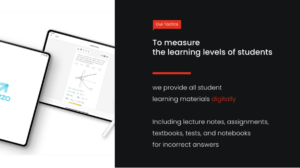
Transitioning to the paperless and digital framework did result in some improvement in student performance, though it was not without its limitations. Despite the progress noted outside the classroom, accurately assessing students’ understanding during live sessions continued to be challenging. Conventional instructional methods fell short of assessing students’ grasp of the materials, as certain students—especially those seated at the front—often appear to understand, nodding along as if fully comprehending the lessons, which may not always reflect their actual understanding.
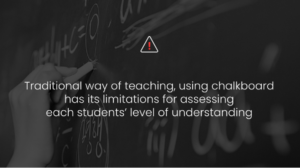
Furthermore, the effectiveness of instruction varies considerably across different LFs, influenced by the disparities in their qualifications and experience, leading to distinct differences in educational outcomes.
Our path to digital transformation was fraught with challenges. However, the adoption of ClassIn last year represented a pivotal shift, enabling us to overcome these challenges effectively. The development of JYSG can thus be clearly divided into the periods before and after the implementation of ClassIn.
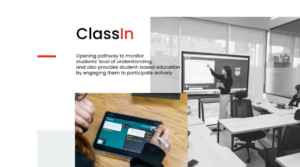
ClassIn facilitates seamless monitoring of students’ learning progress in real-time during classes, promoting a teaching style that hinges on dynamic interaction with students. This approach guarantees heightened engagement and attentiveness.
Feedback on engagement levels from students revealed that traditional blackboard instruction was comparatively less engaging. “In a traditional setting, where you sat could influence how well you focused. ClassIn, however, ensures that regardless of physical location, students remain engaged, participative, and even feel an increased sense of urgency,” students shared.
The same could be said for instructors. LFs have found a renewed sense of engagement in their teaching, estimating their effectiveness to be quadrupled compared to conventional methods.
LFs also observed that the interactive nature of ClassIn-based teaching has eliminated drowsiness among students during lessons, with the practice of calling on students fostering more active involvement and strengthening the teacher-student connection. As a result, classes have become more interesting, making LFs feel that they are making a real difference in their students’ learning experiences.
Beyond these positive feedbacks from students and LFs, the introduction of ClassIn and the move towards blended learning have led to five significant changes at JYSG.
At JYSG, the curriculum is strategically segmented into two key areas: Lecture and Instudy. The Lecture component integrates micro-feedback, addressing common questions, interactive teaching, along with trophies, rewards, and the selection of mentors. On the other hand, the Instudy part involves review sessions, homework evaluations, peer tutoring, support after class, lesson summaries, discussions on questions answered incorrectly, a 24-hour question-and-answer incentive system, and personalized micro-feedback.
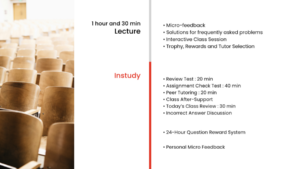
After adopting ClassIn, significant transformations have been observed in our instructional approach:
1) Micro-Feedback
Micro-feedback involves gathering data on students’ learning activities and subsequently providing them with insights. This encompasses areas such as test scores, rankings, homework completion, and study durations.
Before ClassIn, feedback was generally given verbally by teachers in a concise manner. The process has since evolved: teachers now post micro-feedback data into ClassIn daily, offering personalized guidance to each student.
For example, immediate feedback is provided to students who fail to complete their homework, calling attention to them on the spot. This tactic not only motivates but has shown more tangible results than the previous verbal method due to its direct and personalized nature.
2) Interactive Classroom
Previously, our teaching method was primarily lecture-based, with students listening, which hardly engaged them in the lesson. With ClassIn, during interactive classes, a teacher can select a question for three students to answer simultaneously. After each student responds, the teacher provides feedback and the correct answers.
Our traditional teaching model was predominantly lecture-based, limiting student engagement. ClassIn has revolutionized this through interactive classrooms where teachers can pose a question to be answered by three students at the same time. Following their attempts, feedback is given, and correct solutions are shared.
In using ClassIn, we’ve made interactive classroom sessions a staple to boost student engagement, marking a departure from the passive listening model to an active learning environment.
Beyond the virtual environment, it has also become notably easier to invite students to the front to solve a problem in our physical classrooms. Where it once took significant encouragement and persuasion to get a student to present at the front, the introduction of ClassIn has streamlined this process.
For average or under-performing students who typically resist public problem-solving, ClassIn has transformed this reluctance into a normative aspect of their learning. This routine engagement has made them more receptive and even excited about presenting their solution in front of the class.
3) Test Management
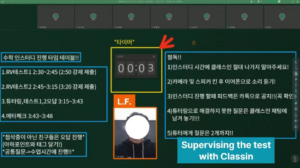
This LF in the image above is using the timer feature of ClassIn. It’s evident that the exam is approaching the end. Employing this method can effectively enhance students’ sense of urgency and focus on the exam.
4) Peer-Tutoring

In each class, we randomly select a peer tutor who, under the LF’s guidance, can answer questions for other students. We group the students with questions together with their peer tutors to facilitate collaborative learning environment.
The LF’s responsibilities extend beyond just answering questions; they also play a crucial role in managing the overall pace during the peer tutoring sessions.
Introducing peer tutoring has lead to several changes. For instance, when students encounter problems, their first instinct isn’t to seek help from instructors but to create a temporary virtual classroom in ClassIn and reach out to peers for assistance.
5) Incorrect Answer Discussion
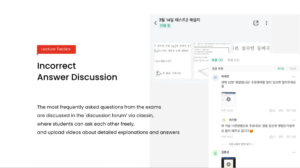
Following each test, the LF selects the top three questions that were answered incorrectly and launches a discussion thread for students to share their solution, with some even recording videos to explain their reasoning and thought processes.
This transition into an interactive and collaborative learning model has brought about noticeable changes for the students:
Firstly, there’s a unanimous feeling among them that this new method of teaching, as opposed to the conventional blackboard approach that often induced boredom or drowsiness, greatly increases class participation and student interest. This shift has made the learning environment much more engaging and appealing.
Secondly, being able to interact during lessons helps students precisely determine which concepts they have successfully grasped and which ones require more work, enhancing their overall comprehension and learning efficiency.
The growth of our institution largely depends on our ability to efficiently onboard new instructors. Training new instructors to meet our high teaching standards used to require a minimum of six months. Following this extensive training period, transitioning to actual teaching roles could take up to an additional year.
The adoption of ClassIn and TeacherIn together has dramatically transformed this process, reducing the transition period from new hire to active teaching to merely two months.
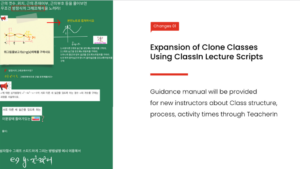
This remarkable increase in efficiency is largely due to new instructors’ ability to easily access teaching manuals created by their predecessors. These manuals, detailing the course structure, sequence, and interactive techniques, empower new instructors to swiftly master the curriculum and deliver high-quality instruction far more quickly than was possible before.
Such an approach has yielded a surprising result in our first-quarter LF evaluations. We assessed the LFs based on classroom professionalism, engagement, and comprehension levels as reported by students during this period.

The left chart represents the evaluation of an experienced instructor A, the middle one shows the evaluation of a new instructor who applied A’s course manual, and the right chart illustrates the evaluation for a teacher with 15 years of experience using traditional blackboard teaching methods.
Remarkably, the novice teacher, with merely two months of teaching experience, received higher evaluation scores than the 15-year veteran who did not incorporate ClassIn into their teaching. This outcome would have been beyond our expectations a year ago. It also highlights that regardless of a teacher’s expertise, they cannot match the effectiveness of those who engage in active interaction and communication with their students.
We attempted to uncover the reason behind this phenomenon, and came to realize that average and under-performing students particularly appreciate courses that are easy to understand and engaging. They consider such interactive and comprehensible courses to be of superior quality.
In light of these insights, JYSG is set to expand our teacher training programs for interactive courses. We are in the process of establishing a teacher training center in May, in partnership with a Korean university renown for its education programs.
Prior to implementing the blended learning approach with ClassIn, our primary challenge was finding a way to standardize instructional protocols and enhance instructional quality at the same time for our LFs.
During the early stages, we began to identify the strengths and weaknesses of each LF in their instructional process. Some demonstrated their skills in creating lesson plans, while others excelled in organizing in-class activities. This led me to think about ways to create a standard protocol that can minimize their weaknesses while maximizing their strengths. Ultimately, the solution was found in using ClassIn’s backend monitoring system.
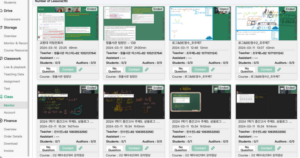
I made the monitoring access available not only to the administrators, but also to all LFs, so that they can observe each other’s classes. The purpose was to facilitate sharing and adoption of best practices among them in a mutually beneficial way.
From an administrative perspective, our evaluation criteria extended beyond basic teaching elements, such as the quality of presented materials, vocal clarity, professional appearance, and overall demeanor. We also considered the degree of interaction within ClassIn, such as the use of trophies as a reward system, the quality of lesson plans, and compliance with the scheduled class time, etc. We rated the LFs based on a set of predefined evaluation metrics and shared their rating with them based on their performance.
Surprisingly, within just three weeks of adopting this class monitoring practice, there was a noticeable improvement in the instructional quality across all LFs, which naturally led to an increase in student satisfaction within the classroom.
Under traditional teaching principles, the expectation is for teachers and students to share the same physical space, with the teacher presenting from the front and students attentively seated, all eyes on the instructor. However, with ClassIn, the concept of “classroom” is changing fundamentally. For students, any place that can host a tablet or computer running ClassIn effectively becomes their classroom. Similarly, for teachers, any setting equipped with essential teaching tools transforms into a teaching space.
Just two weeks after the formal adoption of the blended course model, which allowed students to attend classes in person or from a location of their preference, we observed an unexpected trend. While we had anticipated that only a small number of students, those who preferring a less crowded environment, would opt for online attendance, over 80% of the students expressed a desire to participate virtually.
In conventional blackboard teaching, a student’s location in the classroom significantly influenced their engagement levels, with those seated at the front generally being more attentive. However, within the virtual classroom environment provided by ClassIn, engagement and focus levels remain consistently high across all participants. This high level of engagement is attributed to the platform’s design, which requires active participation and regular checks during interactive sessions, ensuring every student is fully engaged in their learning at all times.
It has now become a common practice for TFs to conduct live lessons from the classroom while students participate from home, or conversely, for TFs to teach from home with students gathering in the classroom.
In Korea, young teachers wishing to travel for a week typically resign from their positions, embark on their journey, and then seek new employment upon their return. We had a teacher planning a month-long trip to Canada, and I suggested they need not resign but could instead teach remotely via ClassIn, allowing them to travel and continue their teaching duties simultaneously.
My thought was that, should this case prove successful, it might herald a new business model.
In Korea, it’s typical for young teachers wishing to travel for more than a week to resign, enjoy their trip, and then look for new employment opportunities afterward. We had a teacher who planned to travel to Canada for a month, and I suggested that resigning was unnecessary. Instead, he could teach remotely via ClassIn, therefore allowing him to travel while continuing his teaching duties at the same time. I envisioned that if this experiment succeeded, it could introduce a new business model.
The outcome exceeded our expectations. While in Canada, the teacher engaged in remote teaching through ClassIn, and students’ performances not only remained consistent but saw substantial improvement over their traditional classroom experiences.
We did have our concerns initially, worried that if the remote teaching didn’t yield effective results, we might lose the entire class of students. However, this case opened up new opportunities for us, demonstrating that such a teaching model could be extended across our branches.
This model accomplishes two major objectives: first, it eliminates the need for large physical classrooms; and second, it significantly addresses teacher welfare concerns. Teachers can deliver the same quality of instruction from anywhere, removing the constraints of physical space.
Such shifts could potentially open numerous opportunities for the extracurricular education market and training institutions.
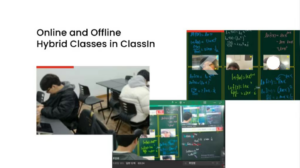
The image displays students in different locations. The far-left picture depicts students engaging in face-to-face learning within a physical classroom, while the image to the far right illustrates a remote learning scenario with students located in different cities.
The adoption of ClassIn led to two interesting developments:
Firstly, we noticed an influx of students from remote cities enrolling in our courses. Secondly, during the recruitment of new students, we received inquiries for the first time from the Gangnam area, a region known for its concentration of tutoring institutions and exceptional teaching quality. Notably, these applicants predominantly had average or below-average academic standings.
Through conversations, we discovered that most tutoring centers in Gangnam primarily cater to high-achievers, leaving students with lesser grades without appropriate course options. These students eventually turned to us. In contrast, students from areas with fewer educational resources, unlike the resource-rich Gangnam, also began reaching out to us. Despite not having launched specific marketing campaigns for online and blended courses, we garnered attention through recommendations from our current students and their parents. While the increase in numbers is still modest, it underscores JYSG’s reputation not just in Bucheon but in attracting students from broader areas as well.
Thus, targeting students with average or below-average academic achievements as our primary customer base has proven to be a very wise decision.
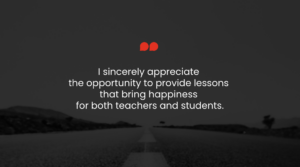
Having been an educator for more than 19 years, I have witnessed numerous changes, but I have never felt happier as I do now. Each day, both our students and teachers are smiling, which is the most significant transformation brought about by ClassIn.
Previously, classrooms often harbored a somber atmosphere, with students wearing expressions of concern, which inadvertently influenced the teachers, leading them to adopt a similarly troubled demeanor. Consequently, an interesting phenomenon occurred: when teaching average or under-performing students, teachers often seemed to gaze into the void rather than at the students themselves.
The situation has drastically improved now. Both students and teachers are brimming with joy, creating a positive feedback loop between them. Anything that brings happiness, in my view, holds the utmost value. This is precisely what we’re accomplishing at present, and we’re eagerly looking forward to shaping a new paradigm in Korea’s educational sector.